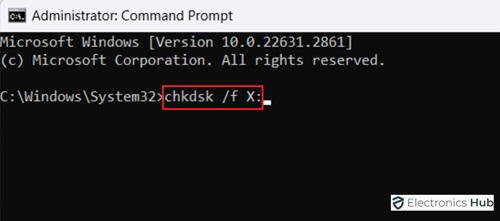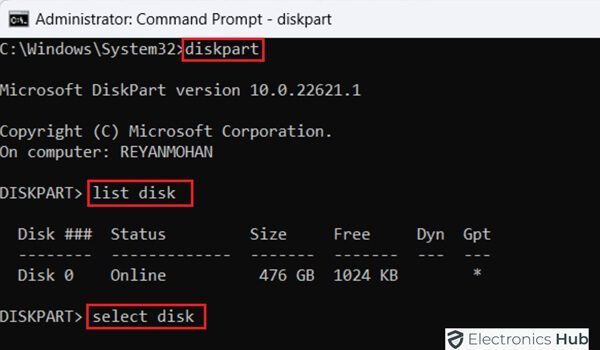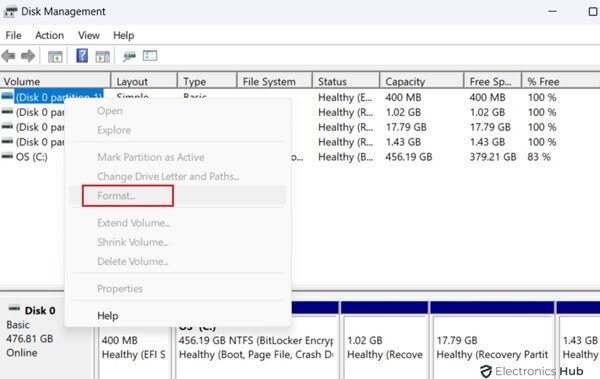Although fixing the “Windows was unable to complete the format” error can be a tedious task, you can solve this problem by following a systematic approach. This error frequently arises when trying to format a storage device, like an SD card or USB drive. You may want to use third-party formatting tools, check for disk errors, or check for write protection in order to solve this issue. Through the application of situation-specific troubleshooting techniques, you can successfully resolve this error and format your storage device on a Windows system.
Also Check:
- System Cannot Find Any Bootable Devices
- How to Format an SSD (Solid State Drive)?
- How To Format SD/ Micro SD Cards?
- How to Fix Automatic Startup Repair Couldn’t Repair Your PC
- How To Fix We Couldn’t Complete The Updates Undoing Changes?
Outline
Toggle- What does the “Windows was Unable to Complete the Format Error Mean”?
- Reasons for Encountering “Windows was Unable to Complete the Format” Error
- Fix the “Windows was Unable to Complete the Format” Error
- 1. Remove and Re-plug the Drive to another USB Port of Your PC
- 2. Plug the Drive into another OS (Mac)
- 3. Run CHKDSK Command
- 4. Using Command Prompt
- 5. Using Disk Management
- 6. Check and Fix Disk Errors
- 7. Remove Write Protection
- 8. Check for Physical Write Protection Switch
- 9. Use Diskpart
- 10. Using Register Key
- 11. Scan Your PC for Malware
- 12. Use a Third-Party Formatting Tool
- Windows was Unable to Complete the Format -FAQs
- Conclusion
What does the “Windows was Unable to Complete the Format Error Mean”?
When the error “Windows Was Unable to Complete the Format” appears, it usually means that the operating system had trouble formatting a storage device—like an external hard drive, SD card, or USB flash drive. Write protection, file system corruption, bad sectors on the storage device, and compatibility problems are some of the causes of this problem. Checking for write protection mechanisms, scanning for disk errors, or successfully formatting the storage device in question with alternative formatting tools are some possible ways to resolve the error.
Reasons for Encountering “Windows was Unable to Complete the Format” Error
There are a number of causes for the “Windows Was Unable to Complete the Format” error, including:
- Write Protection: A physical write protection switch on the storage device might be activated, preventing any alterations to its contents.
- File System Issues: Formatting issues may arise from corruption in the storage device’s file system structure.
- Bad Sectors: The error may arise from the storage medium’s bad sectors impeding the formatting process.
- Incompatible File System: This error may occur when you try to format a drive that has a file system that isn’t compatible with the intended use.
- Broken USB Cable or Port: A broken USB port or cable could interfere with the formatting process.
- Virus or Malware Infection: Security risks may obstruct formatting operations, resulting in an error.
- Faulty Storage Device: Successful formatting may be impeded by physical harm or a malfunctioning storage device.
Resolving the “Windows Was Unable to Complete the Format” error may involve taking appropriate measures to address these possible problems.
Fix the “Windows was Unable to Complete the Format” Error
1. Remove and Re-plug the Drive to another USB Port of Your PC
Removing the impacted drive and plugging it back into a different USB port on your PC is one easy way to fix the “Windows Was Unable to Complete the Format” error. Sometimes, a wrong USB port or a bad connection can be the cause of the error. By taking this easy step, you can potentially resolve the formatting issue and proceed with formatting the storage device in the desired format. It can also help establish a stable connection.
2. Plug the Drive into another OS (Mac)
Plugging the impacted drive into a different operating system, like Mac, may help resolve the “Windows Was Unable to Complete the Format” error. You can get around Windows limitations by using formatting tools and mechanisms that are unique to different operating systems. After connecting the drive to a Mac, open Disk Utility and try formatting the drive there. This cross-platform method could help resolve formatting problems unique to Windows and allow formatting to function correctly on Mac OS.
3. Run CHKDSK Command
Use the CHKDSK command to fix the “Windows Was Unable to Complete the Format” error. Press Enter after opening Command Prompt as administrator and typing “chkdsk /f X:” (inserting X as the drive letter of the impacted device). Disk errors are checked and fixed with this command. Once finished, try formatting the device once more. File system problems can be fixed by CHKDSK, which may also be able to fix formatting errors and enable the formatting process to be successfully completed.
4. Using Command Prompt
Try these steps to resolve the “Windows Was Unable to Complete the Format” error with Command Prompt. Start by launching Command Prompt in administrator mode. After that, input “diskpart” and hit Enter. After that, type “list disk” to see the available drives, then use “select disk [number]” to choose the desired disk. Lastly, use the “create partition primary” command after entering “clean” to erase all data and partitions. Next, type “format fs=ntfs” (or the file system of your choice) and hit Enter to format the disk.
5. Using Disk Management
Use Disk Management to fix the “Windows Was Unable to Complete the Format” error. You may get to it by finding the target drive, choosing “Disk Management,” and then right-clicking the Start button. To change the file system, right-click on the drive, select “Format,” and then adjust. Make sure that “Perform a quick format” is chosen. To begin the formatting process, click “OK”. Disk Management’s powerful features frequently get past formatting roadblocks, fixing the issue and enabling the storage device to be successfully formatted.
6. Check and Fix Disk Errors
Disk errors must be checked and fixed in order to resolve the “Windows Was Unable to Complete the Format” error. The storage device must first be inserted before you can right-click on it and choose “Properties.” Select “Check” from the Error-checking section of the “Tools” tab. To scan and fix disk errors, adhere to the instructions displayed on the screen. By taking care of any possible file system problems, this procedure increases the chances of formatting being successful and gets rid of the error.
7. Remove Write Protection
Make sure the storage device doesn’t have a physical write protection switch before attempting to fix the “Windows Was Unable to Complete the Format” error brought on by write protection. Toggle it to the off position if it is there. Alternatively, you can turn off write protection by modifying the registry or using diskpart commands. Try formatting the device once more after making these adjustments. By removing the write protection barrier, this procedure enables Windows formatting to proceed successfully without the previously mentioned error.
8. Check for Physical Write Protection Switch
The first step in fixing the “Windows Was Unable to Complete the Format” error is to make sure the storage device has a physical write protection switch. If this switch is turned on, write operations are stopped. Please ensure the switch is unlocked by finding it on the device, which is typically located on the side or back. Try formatting the storage device through Windows once more after the write protection has been disabled to see if the problem still exists.
9. Use Diskpart
Open the Command Prompt with administrative privileges to fix the “Windows Was Unable to Complete the Format” error using Diskpart. Type “diskpart” and press Enter. Then, execute commands such as “list disk,” “select disk [disk number],” “clean,” and “create partition primary.” Afterwards, format the partition using “format fs=ntfs” (replace “ntfs” with your preferred file system). This Diskpart method often resolves formatting issues by directly interacting with the disk’s partitioning and formatting processes.
10. Using Register Key
Try editing the Registry key to address the “Windows Was Unable to Complete the Format” error. Press Win + R, type “regedit,” and navigate to “HKEY_LOCAL_MACHINE\SYSTEM\CurrentControlSet\Control\StorageDevicePolicies.” If “WriteProtect” exists, set its value to 0; if not, create a new DWORD named “WriteProtect” and set it to 0. Restart your system, then attempt to format the storage device again. This Registry adjustment often resolves write protection issues causing the formatting error.
11. Scan Your PC for Malware
Consider running a malware scan on your computer to resolve the “Windows Was Unable to Complete the Format” error. This problem can arise from malicious software interfering with formatting procedures. Make use of reliable antivirus or anti-malware software to perform a comprehensive system scan. Remove malware as soon as it is found to guarantee a clean environment. Take a big step toward fixing the problem by trying the formatting procedure once more after removing the malware to see if the error still occurs.
12. Use a Third-Party Formatting Tool
You can use a third-party formatting tool to fix the “Windows Was Unable to Complete the Format” error. These programs can get around some of the restrictions the Windows operating system puts in place and frequently offer sophisticated formatting options. Choose a trustworthy third-party formatting program, adhere to the tool’s specific instructions, and start the formatting procedure. This alternate method might successfully fix the issue and enable easy storage device formatting.
Windows was Unable to Complete the Format -FAQs
Ans: When the error message “Windows was unable to complete the format” appears, it means that the operating system ran into problems when trying to format a USB drive or SD card. The successful formatting of the storage medium may be hampered by issues such as write protection, file system corruption, bad sectors, or compatibility issues.
Ans: A number of factors, including write protection on the storage device, file system corruption, the existence of bad sectors, an incompatible file system for formatting, problems with the USB port or cable, malware or virus infections, and physical damage or malfunction of the storage device, can cause the “Windows was unable to complete the format” error. Taking care of these issues can assist in fixing the Windows formatting error.
Ans: First, look for a physical write protection switch on the storage device to remove write protection and fix the “Windows was unable to complete the format” error. If there isn’t a switch, open File Explorer’s disk properties, select the “Security” tab and change the permissions. Alternatively, you can clear write protection attributes and enable successful formatting by using the Command Prompt and the “diskpart” command.
Ans: Yes, you can fix the Windows “Windows Was Unable to Complete the Format” error by using Disk Management. Locate the target drive in Disk Management, then right-click and choose “Format.” Make sure you select the appropriate file system before starting the formatting. If this technique doesn’t work, though, you might need to look into other options, like using third-party formatting software or looking for write protection.
Ans: Use the Command Prompt to start a disk check in order to resolve file system corruption that is causing the “Windows was unable to complete the format” error. Execute the command “chkdsk /f X:” (insert drive letter X here). This tool will identify and resolve file system problems. Once finished, try formatting the storage device once more to fix the corruption-related error the file system brings.
Conclusion
In summary, the “Windows was unable to complete the format” error is a frustrating problem that is frequently caused by bad sectors, write protection, or file system corruption. A systematic approach is required to fix this error, which may involve using third-party formatting tools, such as chkdsk, to address file system corruption or verifying for write protection. Every circumstance might call for a different response. It will take perseverance and careful consideration of the particulars to successfully format your storage device and resolve this error. Through comprehension and resolution of the underlying reasons, users can effectively navigate these obstacles, guaranteeing effective data administration and device usability on Windows systems.




